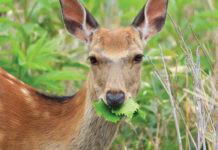
Read about Asian giant “murder hornets?” Want to stop their spread? Live in Washington state? The Washington State Department of Agriculture (WSDA) is looking for volunteers within the state to participate in helping trap Asian giant hornets starting in July. The insects, which have made headlines across the US as murder hornets, are a serious threat to honeybees, other insects, and even humans. If it becomes established, this hornet will have negative impacts on the environment, economy, and public health.
Although WSDA invites anyone in Washington to participate in trapping, the agency is particularly interested in volunteer trapping in Whatcom, Skagit, Island, San Juan, Jefferson, and Clallam counties. In December 2019, WSDA received and verified two reports of Asian giant hornet near Blaine. These are the first-ever sighting in the US. Canada had also discovered Asian giant hornet in two locations in British Columbia in the fall of 2019.
By contrast, the WSDA urges those outside of WA state to NOT build traps. There are no known sightings of Asian giant hornets anywhere else in the US and trapping for them outside of WA will likely do more harm than good by catching native desirable insects, according to WSDA.
Keep in mind that Asian giant hornets pose a risk to human health. While they do not generally bother humans, they will attack if they feel threatened. Participating in Asian giant hornet trapping could increase your risk of being stung by Asian giant hornets. Be sure to seek immediate medical attention if you have a reaction or are stung multiple times. Should you locate a suspected Asian giant hornet nest, DO NOT approach or attempt to remove it. Note the location and report it to WSDA immediately. If you are allergic to bee or wasp stings, you should NOT engage in trapping for Asian giant hornets.

In order for trapping to be successful, those who participate should know that trapping is a commitment. It will require you to:
- obtain materials to build and maintain traps (see below);
- log your traps on WSDA’s online mapping system;
- check your traps weekly for 17 weeks starting in July and into the fall; and
- photograph all specimens and submit photos and any collected bee, wasp, or hornet specimens to WSDA.
The full, easy-to-follow instructions, from building the bottle trap to preparing your samples, is available in a printable pdf. The trap targets Asian giant hornet workers in the summer and fall and is the same one used by the hornet program in Nagoya, Japan.











![[VIDEO] Dickies®: Discover Workwear That’s Anything But Uniform](https://turfmagazine.com/wp-content/uploads/2023/06/1647663814-4b1a2a7742790a9b1e97a3b963477850192e1d6a9dfba9b07214a77bae25d6e3-d-218x150.jpg)



























![[VIDEO] Dickies®: Discover Workwear That’s Anything But Uniform](https://turfmagazine.com/wp-content/uploads/2023/06/1647663814-4b1a2a7742790a9b1e97a3b963477850192e1d6a9dfba9b07214a77bae25d6e3-d-324x160.jpg)